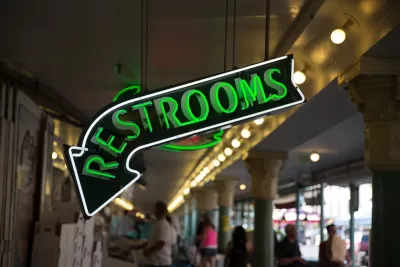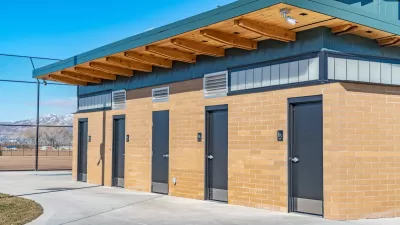For parents of young children, people with mobility equipment, and others, a lack of accessible public restrooms can mean limited outings.

In a piece republished in The Good Men Project, Emma Durand-Wood argues that a lack of public bathrooms is “not just an annoyance. It really affects people’s lives.”
According to Durand-Wood, “A 2019 report out of the U.K. included some grave findings. The study found that 20% of people don’t feel able to go out as much as they’d like to, specifically because of bathroom access. When my kids were young, I would have absolutely counted myself in that 20%. For those with medical conditions requiring frequent toilet use — like diabetes or bladder, bowel, or prostate conditions — this rose to 43%.”
The study also revealed that people restrict their liquids intake to limit how often they’ll need to use the bathroom, leading to dehydration that can exacerbate medical problems. Even when they are available, bathrooms are sometimes inaccessible to people with mobility issues or equipment.
Why have we decided that bathrooms are a must for special events and essential for tourists, yet our everyday selves aren’t worthy?
Durand-Wood concludes, “Even though the public benefits of bathrooms are so high for such a relatively low cost, we can readily grasp that this type of infrastructure will need ongoing, nonnegotiable maintenance, so we don’t even build them in the first place. It’s a bold contrast to million- or billion-dollar road expansions that provide very little return on investment and whose costs for maintenance and eventual replacement we give virtually no thought.”
FULL STORY: Dignity, Inclusivity and Walkability: How Public Bathrooms Help Cities Flourish

Study: Maui’s Plan to Convert Vacation Rentals to Long-Term Housing Could Cause Nearly $1 Billion Economic Loss
The plan would reduce visitor accommodation by 25,% resulting in 1,900 jobs lost.

North Texas Transit Leaders Tout Benefits of TOD for Growing Region
At a summit focused on transit-oriented development, policymakers discussed how North Texas’ expanded light rail system can serve as a tool for economic growth.

Using Old Oil and Gas Wells for Green Energy Storage
Penn State researchers have found that repurposing abandoned oil and gas wells for geothermal-assisted compressed-air energy storage can boost efficiency, reduce environmental risks, and support clean energy and job transitions.

Santa Barbara Could Build Housing on County Land
County supervisors moved forward a proposal to build workforce housing on two county-owned parcels.

San Mateo Formally Opposes Freeway Project
The city council will send a letter to Caltrans urging the agency to reconsider a plan to expand the 101 through the city of San Mateo.

A Bronx Community Fights to Have its Voice Heard
After organizing and giving input for decades, the community around the Kingsbridge Armory might actually see it redeveloped — and they want to continue to have a say in how it goes.
Urban Design for Planners 1: Software Tools
This six-course series explores essential urban design concepts using open source software and equips planners with the tools they need to participate fully in the urban design process.
Planning for Universal Design
Learn the tools for implementing Universal Design in planning regulations.
Ascent Environmental
Borough of Carlisle
Institute for Housing and Urban Development Studies (IHS)
City of Grandview
Harvard GSD Executive Education
Toledo-Lucas County Plan Commissions
Salt Lake City
NYU Wagner Graduate School of Public Service





























